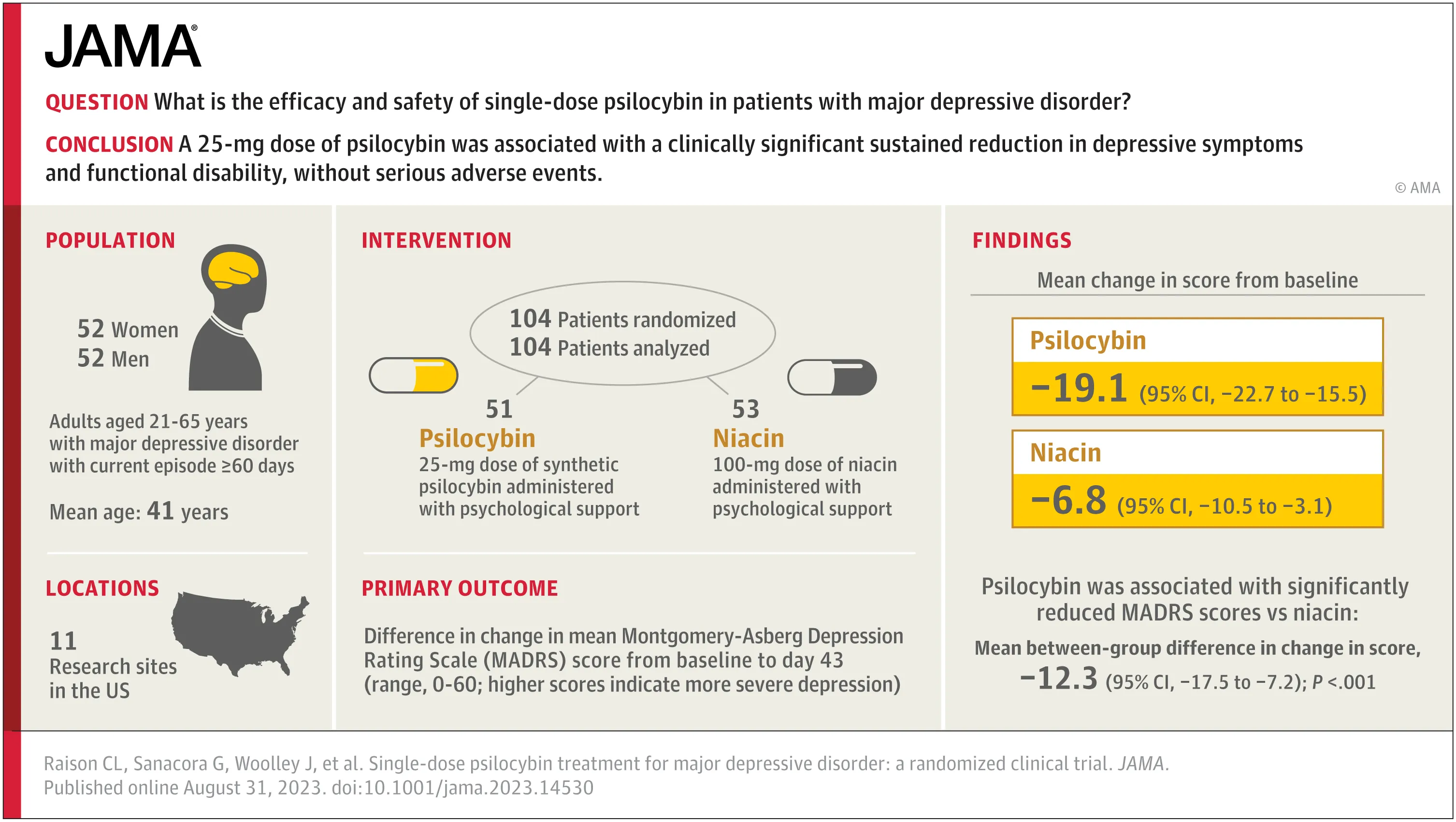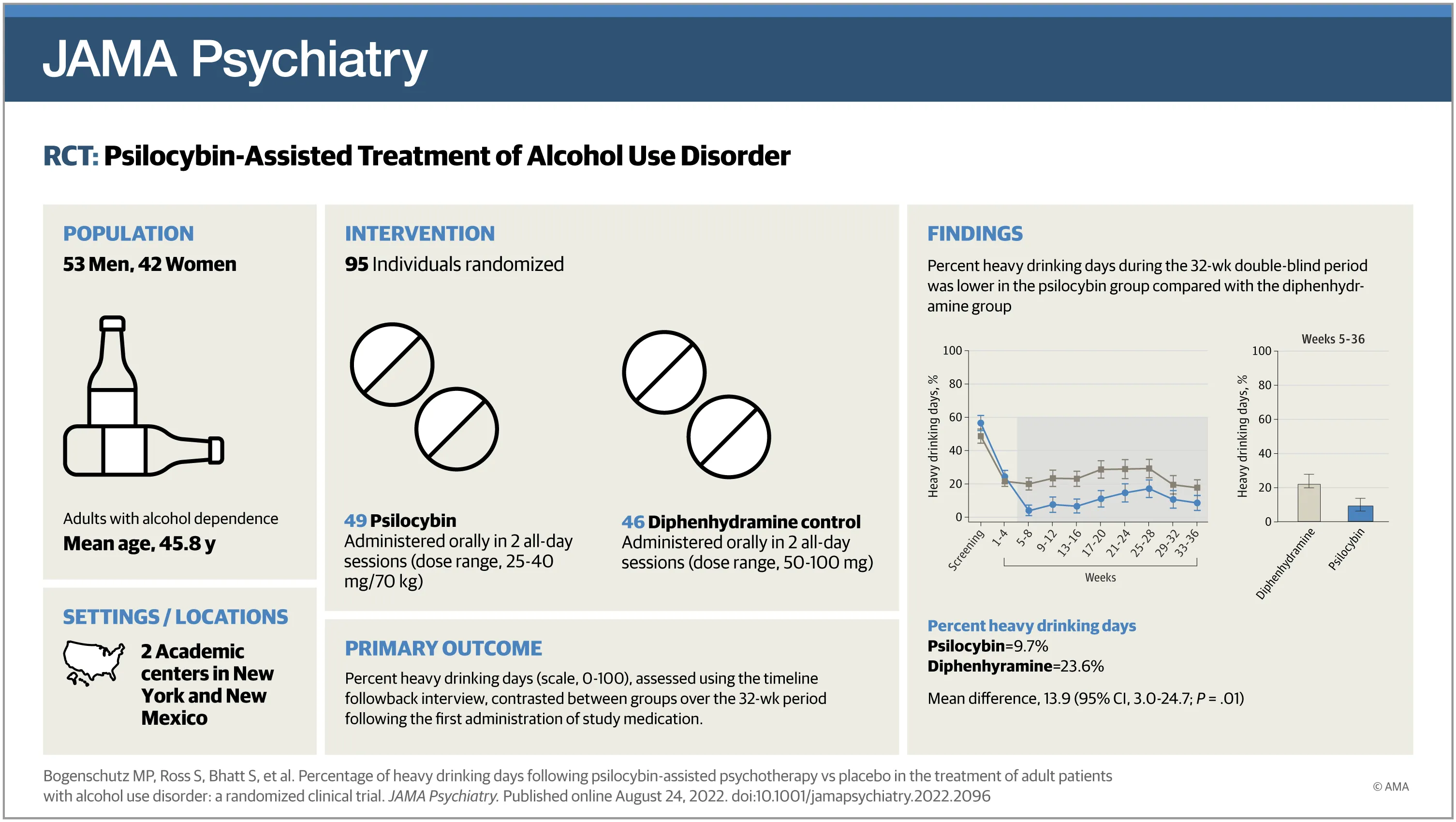Citations
1. Single-Dose Psilocybin Treatment for Major Depressive Disorder: A Randomized Clinical Trial
A study was conducted to evaluate the safety and efficacy of psilocybin in patients with major depressive disorder. A total of 104 adults participated in the study.
Approximately half the participants received psilocybin, while the other half received a placebo. Both groups underwent preparatory sessions with two medical professionals, and were supervised during their experience.
The study found that a 25mg dose of psilocybin was associated with a lasting reduction in depressive symptoms, without serious adverse events. This was measured by recording the difference in each participants Montgomery-Asberg Depression Rating Scale (MADRS) scores.
The average reduction in score for the psilocybin group was nearly triple the reduction seen in the control group.

2. Percentage of Heavy Drinking Days Following Psilocybin-Assisted Psychotherapy vs Placebo in the Treatment of Adult Patients With Alcohol Use Disorder: A Randomized Clinical Trial
A study was conducted to determine whether psilocybin-assisted treatment improved drinking outcomes compared to a placebo in patients with alcohol use disorder. The study consisted of 93 participants. 49 received a high dose of psilocybin, and 46 received a placebo instead. Both groups also underwent 12 weeks of therapy.
The study followed up with participants for 32 weeks after the study and found that the group which underwent psilocybin-assisted therapy had a significant decrease in heavy drinking days compared to the placebo group.

3. Psilocybin Produces Substantial and Sustained Decreases in Depression and Anxiety in Patients with Life-Threatening Cancer: A Randomized Double-Blind Trial
Five studies evaluating the effectiveness and tolerability of psilocybin-assisted therapy for treating end-of-life anxiety symptoms were examined. All five studies specifically focused on cancer and/or HIV patients.
The examination found that psilocybin-assisted therapy is superior to a placebo in treating end-of-life anxiety. This effect was observed as soon as the day after the session, and remained a month later.
4. What Are the Current Criminal Penalties for Psychedelics?
We have curated a spreadsheet detailing the current criminal penalties of entheogens (aka psychedelics) in Wisconsin. The first sheet contains the different relevant criminal codes and a description of the different felony classes. The second sheet contains a listing of other felonies and what the equivalent entheogen violation would be.
The spreadsheet can be found here.
5. Mescaline Use for 5700 years
This article describes how archaeological investigations in Mexico and Texas have shown that the use of the peyote cactus in the region goes back to around 8500 BC. The peyote cactus contains mescaline, an entheogen.
6. Naturalistic Use of Mescaline Is Associated with Self-Reported Psychiatric Improvements and Enduring Positive Life Changes
A survey was conducted asking 452 adults about their most memorable mescaline experiences and the outcomes they attribute to them.
Approximately half of the respondents reported having a psychiatric condition (like depression and anxiety). Of that half, approximately 67% reported improvements in their conditions following their most memorable mescaline experience.
No respondents reported seeking medical attention as a result of their mescaline use. Most participants (60%) reported using mescaline less than once a year.
7. The Prevalence and National Burden of Treatment-Resistant Depression and Major Depressive Disorder in the United States
A study was conducted to evaluate how many American adults suffer from treatment-resistant depression and major depressive disorder.
The study estimated that nearly 12 million American adults are being medicated for major depressive disorder or treatment-resistant depression.
8. Adverse Effects of Psychedelics: From Anecdotes and Misinformation to Systematic Science
A group of researchers conducted a review of evidence of potential harm caused by classic entheogens (aka psychedelics). They aimed to address physiological and psychiatric risks such as abuse potential, dependence, toxicity, and overdose.
The review found that the medical risks of classic entheogens are minimal and psychological risks are largely unsupported by currently available scientific evidence.
9. Pilot Study of the 5-HT2AR Agonist Psilocybin in the Treatment of Tobacco Addiction
A study was conducted to determine the safety and feasibility of supplementing standard smoking cessation treatment with psilocybin sessions. In total, 15 smoking adults completed the study with most undergoing three psilocybin sessions over 15 weeks.
The study observed a 80% smoking cessation rate, with 12 out 15 participants found to be abstinent from smoking at a 6-month followup. This substantially exceeds the usual rates reported by other treatment methods (typically less than 35%). No significant adverse events occurred across any of the psilocybin sessions.
10. First-In-Kind Psychedelic Trials Treat Opioid and Methamphetamine Use Disorders
This UW-Madison press release describes two new clinical trials being conducted at the UW-Madison Transdisciplinary Center for Research in Psychoactive Substances. The trials aim to determine the safety and feasibility of supplementing standard buprenorphine-naloxone maintenance therapy with psilocybin.
Buprenorphine-naloxone is a medication used to help treat opioid use disorder by relieving cravings and withdrawal symptoms.
11. 2025 Budget Outlook
The City of Madison is facing a 2025 budget deficit. Linked below is a presentation the City has put together detailing the problem.
12. Tripping Over the Other: Could Psychedelics Increase Empathy
This research article explores the clinical evidence that entheogens (aka psychedelics) increase empathy.
It finds that the evidence implies entheogens likely lead to increased empathy, openness and social connectedness.
13. The Love Project: Preliminary Outcomes of a Survey Study Among Psychedelic Users
A survey study was conducted to collect and examine profound experiences occasioned by entheogens in which love was a central theme.
Approximately 579 responses were collected. The common theme between them is increased love for self, community and others.
This data was recently presented for the first time at the International Forum On Consciousness in Fitchburg, WI!
14. Psychedelics Promote Neuroplasticity Through the Activation of Intracellular 5-HT2A Receptors
This research article describes how entheogens (aka psychedelics) promote neuroplasticity, or the ability for the brain to forge new pathways. The research article states that the neuroplasticity is due to entheogens binding to the brain's 5-HT2A receptors.
A 5-HT2A receptor is a serotonin receptor. Serotonin is naturally produced by the body and assists in many important functions such as mood and memory. Many entheogens resemble the chemical structure of serotonin.
15. Catalysts for Change: The Cellular Neurobiology of Psychedelics
This research article, written by a group of researchers from UW-Madison, discusses how entheogens (aka psychedelics) promote neural plasticity in the brain, or the ability for the brain to forge new pathways. This is believed to be central to their therapeutic benefits.
16. Sustained Effects of Single Doses of Classical Psychedelics in Humans
This review article summarizes the evidence that entheogens (aka psychedelics) promote long-lasting positive effects. It finds that entheogens can help improve emotional state in those with and without neuropsychiatric disorders like depression.
Based on current knowledge, it is believed many of these long-lasting positive effects occur due to the increases in neuroplasticity caused by entheogens. Neuroplasticity is the ability for the brain to forge new pathways.
17. Psilocybin can occasion mystical-type experiences having substantial and sustained personal meaning and spiritual significance
A study was conducted to evaluate the short-term and longer-term psychological effects of a high dose of psilocybin. 36 volunteers participated in the study. They all underwent one to two control sessions and a single psilocybin session. All the sessions were supervised.
The study found that when administered under supportive conditions, psilocybin occasions mystical experiences. Two months after their psilocybin session, participants rated their experience as having substantial personal meaning and spiritual significance. They also attributed the experience to sustained positive changes in attitude and behavior.
18. Psychedelics not linked to mental health problems or suicidal behavior: A population study
A population study was conducted to determine whether there is evidence of a link between entheogen (aka psychedelic) use and mental health problems or suicidal behavior. The study used a dataset of 130,000 random US adults. Approximately 15% of the adults in the dataset reported use of an entheogen.
The study found no evidence that entheogen use is a risk factor for mental health problems or suicidal behavior. It also notes that these results are consistent with previous population studies, controlled trials, and studies of regular participants in legally recognized religious ceremonies involving entheogens (such as the use of the peyote cactus in Indigenous ceremonies).
19. Decriminalized and Active Cities
Decriminalize Nature is a national organization with chapters all over the country. The national team maintains a map of all the cities which have decriminalized or have a local decriminalization effort.
The map can be found here.
Source: Decriminalized and active cities